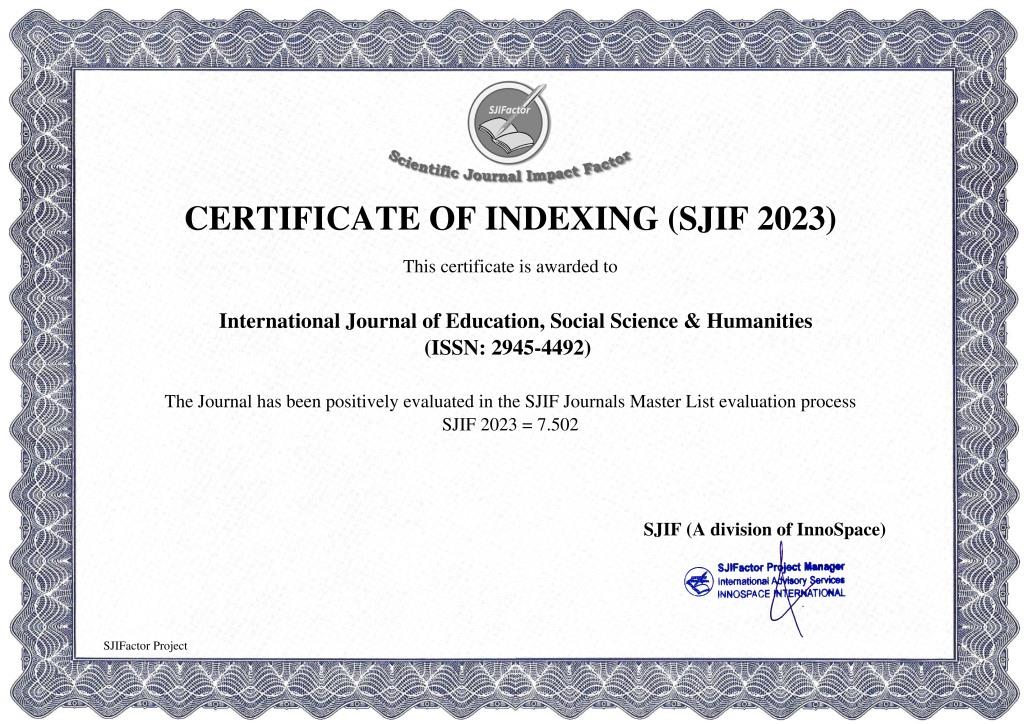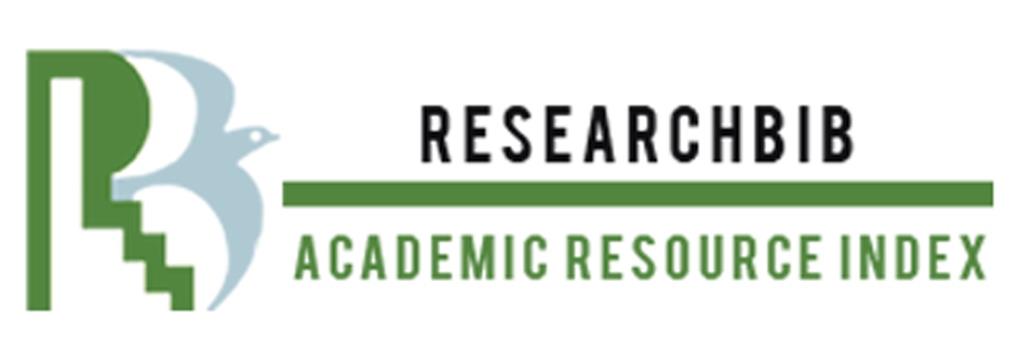GAMIFICATION
Keywords:
gamification, game designers, Duolingo, Minecraft Education Edition, Classcraft, leaderboards, online learning, endorphin, serotonin, oxytocin.Abstract
This article focuses on the importance of the game during the lesson and how it can contribute to the development of education quality. Gamification of education helps to instill interest in learning in both children and adults. This is a universal method that is suitable for all ages. At the same time, game-based learning achieves its goal: with the right approach, it helps to gain knowledge and learn to apply it in practice.
References
Orlova, O. V. Gamification as a way of organizing training / O. V. Orlova, V. N. Titova. — Bulletin of TSPU (Bulletin of TSPU). — 2015. — № 9 (162)
R. Harris, R. Ahlers, J.E. Driscoll Games, motivation and Learning: Modeling and Modeling of Research and Practice Models, 33 (2002), pp. 441-467
S. Deterding, D. Dixon, R. Khaled, L. Nake From game design elements to playfulness: the definition of Gamification Proceedings of the 15th International Academic Conference MindTrek: Vision of Future Media Environments (2011), pp. 9-15
Alekseeva A.Z., Solomonova G.S., Aetdinova R.R. Gamification in education // Pedagogy. Psychology. Philosophy. 2021. №4 (24).
E. Andersen Optimization of adaptability in educational games Proceedings of the International Conference on the Basics of Digital Games (2012), pp. 279-281
Gimelstein E.A., Godvan D.F., Stetskaya D.V. Application of gamification tools in education // Business education in the knowledge economy. 2020. №3 (17).
Bafoeva, R. (2023). INGLIZ VA O’ZBEK MAQOLLARINING SHAKLLANISH VA O’RGANILISH MASALALARI. НаучныйФокус, 1(3), 29-31.
Bafoeva, R. (2023). INGLIZ VA O’ZBEK MAQOLLARINING KOGNITIV TAHLILIIngliz vаozbek mаqollаritizimlаri hаqidа gаp ketgаndаulаrningmohiyаtibir-biridаn аjrаlib turishiаniqbo'lаdi, chunkiulаr turlixil tаrixiy, ijtimoiyvaiqtisodiyshаroitlаrdаrivojlаngаn, vаbu mаqoll. WorldofScience, 6(6), 207-211.
Ismatovna, I. L. (2021). Typology of parts of speech and content of grammatical categories in two languages. ACADEMICIA: An International Multidisciplinary Research Journal, 11(8), 53-57.
Ismatovna, I. L. (2023). Activities for presenting and practicing vocabulary. JOURNAL OF SCIENCE, RESEARCH AND TEACHING, 2(4), 130-133.
Jabborova, A. (2023). THE IMPACTS OF PHYSICAL CLASSROOM SPACES ON STUDENTSINVOLVEMENT HOW CAN STUDENTSENGAGEMENT BE PROMOTED BY PHYSICAL CLASSROOM SPACES?. Modern Science and Research, 2(3), 115-121.
Jabborova, A. J. (2023). HOW WOULD YOU MEASURE CREATIVITY AND INNOVATION? WHY?. GOLDEN BRAIN, 1(10), 20-24.
Jabborova, A. (2023). THE USE OF ASPECT IN “WOMEN IN LOVE” BY DAVID LAWRENCE. Modern Science and Research, 2(6), 345-356.
Jabborova, A. (2023). WHAT IS DESIGN THINKING?. TalqinVaTadqiqotlar, 1(13). извлеченоотhttp://talqinvatadqiqotlar.uz/index.php/tvt/article/view/941
Jabborova Aziza Jobirovna. (2023). THE CATEGORY OF ASPECT IN ENGLISH GRAMMAR. Academia Science Repository, 4(05), 10–27. Retrieved from http://academiascience.com/index.php/repo/article/view/443
Jabborova, A. (2023). THE CATEGORY OF VOICE IN ENGLISH GRAMMAR. Modern Science and Research, 2(7), 430–433. Retrieved from https://inlibrary.uz/index.php/science-research/article/view/22266
Jabborova, A. (2023). THE CATEGORY OF PERSON IN ENGLISH GRAMMAR. Modern Science and Research, 2(8), 367–375. Retrieved from https://inlibrary.uz/index.php/science-research/article/view/23467
Jabborova, A. (2023). THE CATEGORY OF PERSON IN ENGLISH GRAMMAR, THE ANALYSIS OF THEIR USE IN “LOVУ OF LIFE” WRITTEN BY JACK LONDON. Modern Science and Research, 2(9), 97–108. Retrieved from https://inlibrary.uz/index.php/science-research/article/view/24087
Nosirova, D. (2023). SECOND LANGUAGE ACQUISITION AND THE ROLE OF DIDACTIC GAMES IN SLA. Modern Science and Research, 2(5), 1143–1145. Retrieved from https://inlibrary.uz/index.php/science-research/article/view/20556
НосировaДилнозаРизокуловна. (2023). ТИПОЛОГИЧЕСКАЯ ХАРАКТЕРИСТИКА ЧАСТЕЙ РЕЧИ РУССКОГО, УЗБЕКСКОГО И АНГЛИЙСКОГО ЯЗЫКОВ И МЕТОДИКА ИХ ОБУЧЕНИЯ В НАЧАЛЬНЫХ КЛАССАХ .PEDAGOGSJurnali, 1(1), 87. Retrieved from https://pedagoglar.uz/index.php/ped/article/view/5399
Tursunova, M. (2023). BADIIY TARJIMADA LINGVOKULTUROLOGIK XUSUSIYATLAR. Журнал: Союз Hаукии Oбразования, 5(2), 12-15.
Utkirovna, B. S. (2023). Characteristics of the Works of Charles Dickens. European Science Methodical Journal, 1(3), 24-28.
Orifjonovich, O. A. (2023). METAFORANING KO'P TARMOQLI VA FANLARARO O'RGANILISHI.
Sulaymonovna, Q. N., Tashpulatovna, K. M., &Orifjonovich, O. A. (2023). COGNITIVE AND LINGUOCULTURAL CHARACTERISTICS OF METAPHORS. Finland International Scientific Journal of Education, Social Science & Humanities, 11(3), 849-854.
Zayniddinovna, T. N. (2021). The Image of the Eastern Ruler in the Works of Christopher Marlowe. Central Asian Journal Of Social Sciences And History, 2(10), 10-14.
Zayniddinovna, T. N. (2022). The Problem of “A Strong Personality” in Shakespeare’Dramas: Richard III and Macbeth. MiddleEuropeanScientificBulletin, 20, 7-10.
Zaynitdinovna, T. N. (2022). Lyrical Dialogue in Shakespeare's Poems as a Reflection of Renaissance Anthropocentrism and a Strong Personality. MiddleEuropeanScientificBulletin, 21, 120-125.
Ташева, Н. З. (2022). КРИСТОФЕР МАРЛОУ (ЛИТЕРАТУРНЫЙ АНАЛИЗ): ТАМЕРЛЕН ВЕЛИКИЙ КАК ТИП ЛИЧНОСТИ ВОСТОЧНОГО ПРАВИТЕЛЯ. EurasianJournalofAcademicResearch, 2(2), 234-239.
Zayniddinovna, T. N. (2022). THE CHARACTER OF STRONG PERSONALITY ACCORDINGLY WITH EASTERN THEMATICS IN CHRISTOPHER MARLOWE’S PLAY" TAMBURLAINE THE GREAT". InternationalJournalOfLiteratureAndLanguages, 2(08), 9-14.
Zayniddinovna, T. N. (2022). STRONG PERSONALITY’S ARTISTIC AND POETIC REFLECTION IN THE RENAISSANCE EPOCH. InternationalJournalOfLiteratureAndLanguages, 2(11), 43-51.
nafisaZayniddinovna, T. (2022). Lexico-Semantic Word Production as a Way of Forming Theater Terminology of the English Language. AmericanJournalofSocialandHumanitarianResearch, 3(10), 144-150.
Zayniddinovn, T. N., &Sharofiddinovich, S. S. (2021). General cultural and educational values of ancient-classic latin language. CentralAsianJournalofTheoreticalandAppliedScience, 2(5), 77-80.
Zayniddinovna, T. N. (2023). CHARACTERIZATION OF THE IMAGE OF AMIR TEMUR IN CHRISTOPHER MARLOWE'S DRAMA" TAMERLANE THE GREAT". International Journal Of Literature And Languages, 3(02), 36-43. SCIENCE AND INNOVATION IN THE EDUCATION SYSTEM International scientific-online conference 54
Fayzullayeva, N. S. qizi . (2023). Theoretical Views on the Use of the Term "Concept" in Cognitive Linguistics. EUROPEAN JOURNAL OF INNOVATION IN NONFORMAL EDUCATION, 3(5), 27–31. Retrieved from https://www.inovatus.es/index.php/ejine/article/view/1685
Fayzullayeva, N. (2023). USAGE OF THE FLORA IN THE EARLY MODERN ENGLISH POETRY. Modern Science and Research, 2(9), 36–39. Retrieved from https://inlibrary.uz/index.php/science-research/article/view/24078
Sadullayev, U. . (2023). THE ROLE OF WOMEN IN NEIGHBORHOOD MANAGEMENT IN UZBEKISTAN. Modern Science and Research, 2(9), 132–135. Retrieved from https://inlibrary.uz/index.php/science-research/article/view/24060
Tasheva, N. (2023). EXPRESSION OF LEXICAL-SEMANTIC AND SOCIOSPIRITUAL PARAMETERS IN THE CREATION OF GREAT HUMAN FIGURES IN ENGLISH RENAISSANCE DRAMA. Академические исследования в современной науке, 2(21), 50-57
Tasheva, N. (2023). LINGUISTIC AND STYLISTIC FEATURES OF THE TRAGEDY" TAMERLANEE THE GREAT". Общественные науки в современном мире: теоретические и практические исследования, 2(8), 11-14.
Tasheva, N. (2023). " TAMERLANE THE GREAT" AS A PHENOMENON OF THE WORLDVIEW OF RENAISSANCE HUMANISM. Педагогика и психология в современном мире: теоретические и практические исследования, 2(9), 24- 27
https://cyberleninka.ru/article/n/geymifikatsiya-kak-metod-obucheniya-osobennosti-i-vozmozhnosti
https://trends.rbc.ru/trends/education/605c6f2f9a79473a61646994
https://www.ismart.org/library/uchimsya-igraya-chto-takoe-geymifikatsiya-v-obrazovanii
https://www.unicraft.org/blog/7209/geymifikatsiya-v-obuchenii/














